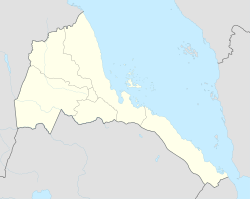Adi Keyh
| Adi Keyh | ||
|---|---|---|
|
|
||
| Coordinates | 14 ° 50 ′ N , 39 ° 22 ′ E | |
| Basic data | ||
| Country | Eritrea | |
| Debub | ||
| ISO 3166-2 | ER-YOU | |
Adi Keyh ( Tigrinya ዓዲ ቀይሕ , also Addi Keyh , Adi Keyih , Adi Qeyh , Adi Caie , Addi Caieh and others, Arabic عدي قيح) Is a city in the region Debub in Eritrea .
It is the center of the Akkele Guzay area and a major market town in the highlands of Eritrea. The residents speak Tigrinya and Saho . Adi Keyh lies at the end of the Ruba Ḥaddas valley , which connects the Akkele Guzay highlands with the Red Sea lowlands .
history
There are a number of archaeological sites in Adi Keyh and the surrounding area, including cave paintings in Awalu Galba (Bäʿatti), Awalo , Jago and other locations and ancient settlement sites with native architecture, cisterns, ceramics, stone tools, bronze artefacts and stone beads. Some of these sites are located directly on the outskirts and are endangered by stone mining and the growth of industry and residential areas. The place of today's Adi Keyh should have belonged to Qohaito and was settled in pre- Aksumite and Aksumite times.
During the colonial era, Adi Keyh was an administrative center and the site of an Italian fort, Catholic mission, secondary school, and agricultural facilities. During Eritrea's War of Independence against Ethiopia in the 1970s and 1980s, it was the garrison town of the Ethiopian military, and in 1977 and 1990 major battles took place between Eritrean rebels and the army. As a result of the war, the area is heavily mined . In 2000, a medical facility with 99 beds was available in the city.
Individual evidence
- ↑ a b c Ezra Gebremedhin: ʿAddi Q äyyəḥ , in: Siegbert Uhlig (Hrsg.): Encyclopaedia Aethiopica . Volume 1: A - C. Harrassowitz, Wiesbaden 2003, ISBN 3-447-04746-1 .
- ^ International Campaign to Ban Landmines: Landmine Monitor Report, 2002. Towards a Mine-Free World. Human Rights Watch New York NY 2002, ISBN 1-56432-277-7 , p. 256.
- ^ Ministry of Health, quoted in in World Bank: The Health Sector in Eritrea. A World Bank country study. World Bank, Washington DC 2004, ISBN 0-8213-5876-6 , p. 27 ( A World Bank country Study ).

